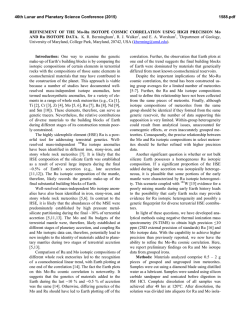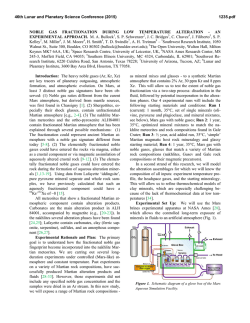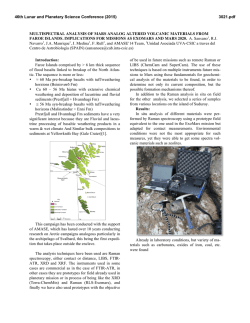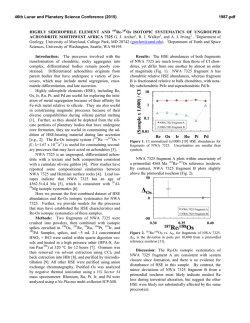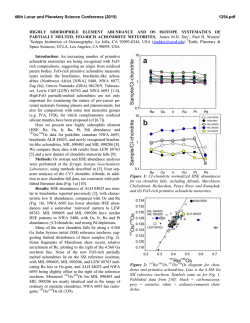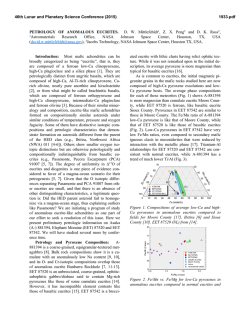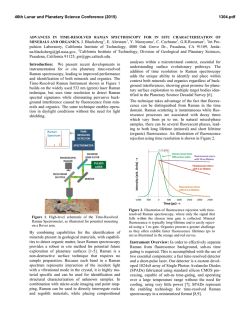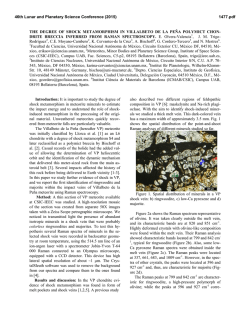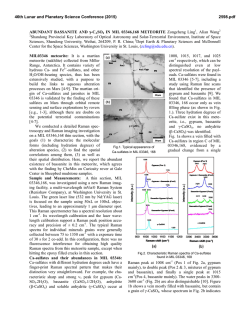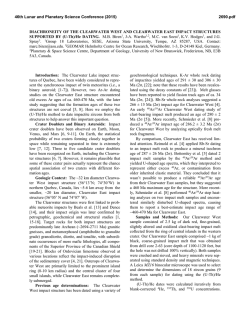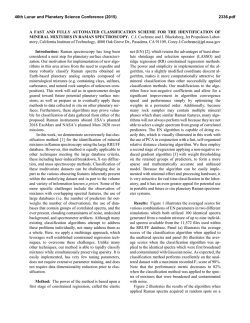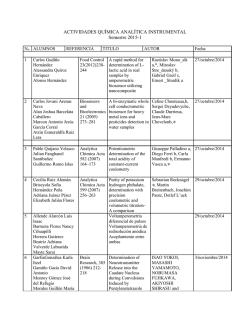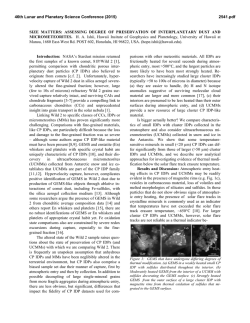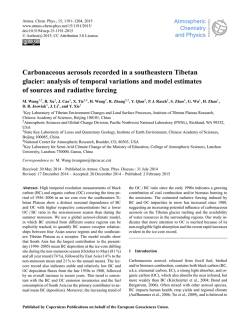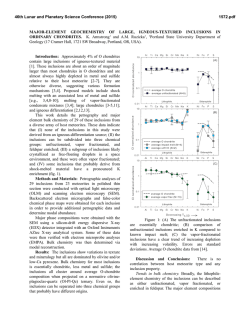
(L4).
46th Lunar and Planetary Science Conference (2015) 1061.pdf NOBLE GAS AND RAMAN SPECTROSCOPIC STUDY OF RESIDUES FROM SARATOV (L4). Sachiko Amari1, Jun-ichi Matsuda2, Kazuhiko Morishita2 and Masayuki Nara3, 1McDonnell Center for the Space Sciences and the Physics Department, Washington University, St. Louis, Missouri 63130 USA ([email protected]), 2Department of Earth and Space Science, Graduate School of Science, Osaka University, Toyonaka, Osaka 560-0043, Japan. 3Laboratory of Chemistry, College of Liberal Arts and Sciences, Tokyo Medical and Dental University, Chiba 272-0827, Japan. Introduction: Q, for quintessence, comprises a very small portion of primitive meteorites, and carries most of the heavy noble gases in the meteorites [1]. Isotopic and elemental compositions of Q-gases have been extensively studied [2-5] and it has been known that the Q-gases have been widely seen in different kinds of meteorites [2, 3, 6-9] and even in graphite nodules in the Canyon Diablo iron meteorite [10]. In contrast, the exact nature of Q remains elusive since the discovery [1]. Q is readily destroyed by oxidants [1] and is most likely a carbonaceous phase [11, 12]. In continuing effort to identify Q, we analyzed the HF-HCl residue, AC, and the oxidized residue, AD (Fig. 1), from the Saratov meteorite (L4) using noble gas mass spectrometry and Raman spectroscopy. Since Q would be lost by oxidation, the difference in characteristics between AC and AD might give us insight into the nature of Q. The noble gas data of AC has already been reported by Matsuda et al. [5]. Experimental: The sample was processed at Washington University in St. Louis, USA. A fragment of Saratov, which weighed 7.1655g, was alternately treated with HF-HCl and HCl to remove silicates. Elemental sulfur was removed with CS2, yielding the HF-HCl residue AC. It comprises 0.76 wt.% of the bulk meteorite. A portion of AC was taken and was oxidized with 0.5N Na2Cr2O7 – 2N H2SO4 at 77°C for 10 hours to destroy Q. The oxidized residue AD comprised 0.61 wt. % relative to the bulk meteorite (Fig. 1). Noble gases of these samples were analyzed using the VG5400 at Osaka University, Japan. The details of the procedure can be found in [5]. The temperature steps are 600, 800, 1000, 1200, 1400, and 1600℃ for AA and AC [5], and 600, 1000, 1200 and 1600℃ for AD [13]. The gas concentrations in the procedural hot blanks at 1600℃ are: 4He = 8.5 × 10–10, 22Ne = 6.2 × 10–13, 36 A r= 1.1 × 10–11, 84Kr = 1.1 × 10–12 and 132Xe = 9.9 × 10–14 cm3STP in the case of the AD measurement [13]. The Raman spectroscopic study was performed at The Tokyo Medical and Dental University. Detailed descriptions of experiments and band fitting are given by Matsuda et al. [4, 14]. In this study, the Raman spectrum was obtained using 10 accumulations of 30-second analysis by using an excitation wavelength of 532 nm (YAG laser, laser power of 1.5-2.4 mW, Kaiser Optical Systems, Inc.). The excitation laser spot size was approximately 2 µm in diameter. It is shown that the higher laser power changes the sample to more amorphous state for carbon material of the carbonaceous chondrite like Allende [14, 15] but 1.5-2.4 mW does not have a large effect on the carbon material in ordinary chondrites. Fig. 1. Separation diagram of Saratov A. Results and Discussion: The heavy noble gases, Ar, Kr and Xe, in AD are two orders of magnitude lower than AC after the oxidation (132Xe: 12 × 10–10 cm3STP/g in AD and 1100 × 10– 10 cm3STP/g in AC), indicating that Q was destroyed by the oxidation. On the other hand, the 4 He and 22Ne concentrations in AA, AC and AD are in the same range (4He: 2.0 – 2.6 × 10–5 cm3STP/g, 22Ne: 6.1 – 10 × 10–8 cm3STP/g). The 46th Lunar and Planetary Science Conference (2015) 3 He/4He ratio of AD (total) is (1.54 ± 0.06) × 10–2 and the 20Ne/22Ne and 21Ne/22Ne ratios of AD (total) are 0.969 ± 0.035 and 0.845 ± 0.010, respectively, confirming the dominance of the cosmogenic component. The He and Ne isotopic ratios in AC and AA also indicate that the cosmogenic He and Ne components are dominant in AA and also even in AC [5]. In AA, silicates are major minerals that contain target elements. Silicates are removed in AC and AD, thus oxides, instead of silicates, must be the carrier of the cosmogenic noble gases. Carbonaceous material is characterized by properties of G and D bands in Raman spectroscopy. The G band is associated with the aromatic plane of graphite. The crystallized graphite shows the G band at 1580 cm–1. The D band is observed for carbon that does not have perfect crystal structure and usually appears at around 1300 cm–1. If carbonaceous matter is a mix of carbons with different degree of crystallization, these parameters are expected to vary. The positions of the G band [ωG (cm–1)] and the D band [ωD (cm–1)] of AC range from 1580 to 1588, and 1337 to 1355, respectively [4]. Those of the G band and D band of AD range from 1580 to 1598, and 1352 to 1375, respectively. After the oxidation, these peak positions shifted toward higher values and the spreads of the peak positions became larger. It indicates that the oxidation might remove a specific kind of carbon, but also changed the crystal structures of carbonaceous matter. In the context of the nature of Q, it can be interpreted either Q is a very small discrete carrier that is not detected in Raman spectroscopy, or Qgases are released by structural changes of carbonaceous matter during oxidation [13]. References: [1] Lewis R. S. et al. (1975) Science, 190, 1251-1262. [2] Huss G. R. et al. (1996) Geochim. Cosmochim. Acta, 60, 3311-3340. [3] Busemann H. et al. (2000) Meteoritics & Planet. Sci., 35, 949-973. [4] Matsuda J. et al. (2010) Geochem. Cosmochim. Acta, 74, 5398-5409. [5] Matsuda J. et al. (2010) Meteoritics & Planet. Sci., 45, 361-372. [6] Alaerts L. et al. (1979) Geochim. Cosmochim. Acta, 43, 1399-1415. [7] Alaerts L. et al. (1979) Geochim. Cosmochim. Acta, 43, 1421-1432. [8] Matsuda J. et al. (1980) Geochim. Cosmochim. Acta, 44, 1861-1874. [9] 1061.pdf Moniot K. M. (1980) Geochim. Cosmochim. Acta, 44, 253-271. [10] Matsuda J. et al. (2005) Meteoritics & Planet. Sci., 40, 431-443. [11] Reynolds J. H. et al. (1978) Geochim. Cosmochim. Acta, 42, 1775-1797. [12] Ott U. et al. (1981) Geochim. Cosmochim. Acta, 45, 1751-1788. [13] Matsuda J. et al. (2014) Meteoritics & Planet. Sci., submitted. [14] Matsuda J. et al. (2009) Geochemical J., 43, 323-329. [15] Morishita K. et al. (2011) Spectroscopy Letters, 44, 459-463.
© Copyright 2025

